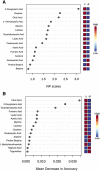Urinary Metabolomic Profile of Youth at Risk of Chronic Kidney Disease in Nicaragua
- PMID: 37068179
- PMCID: PMC10371259
- DOI: 10.34067/KID.0000000000000129
Urinary Metabolomic Profile of Youth at Risk of Chronic Kidney Disease in Nicaragua
Abstract
Key Points:
Urinary concentrations of glycine, a molecule associated with thermoregulation, were elevated among youth from a high-risk region for chronic kidney disease of non-traditional etiology (CKDnt).
Urinary concentrations of pyruvate, citric acid, and inosine were lower among youth at higher risk of CKDnt, suggesting renal stress.
Metabolomic analyses may shed light on early disease processes or profiles or risk in the context of CKDnt.
Background: CKD of a nontraditional etiology (CKDnt) is responsible for high mortality in Central America, although its causes remain unclear. Evidence of kidney dysfunction has been observed among youth, suggesting that early kidney damage contributing to CKDnt may initiate in childhood.
Methods: Urine specimens of young Nicaraguan participants 12–23 years without CKDnt (n=136) were analyzed by proton nuclear magnetic resonance spectroscopy for 50 metabolites associated with kidney dysfunction. Urinary metabolite levels were compared by, regional CKDnt prevalence, sex, age, and family history of CKDnt using supervised statistical methods and pathway analysis in MetaboAnalyst. Magnitude of associations and changes over time were assessed through multivariable linear regression.
Results: In adjusted analyses, glycine concentrations were higher among youth from high-risk regions (β=0.82, [95% confidence interval, 0.16 to 1.85]; P = 0.01). Pyruvate concentrations were lower among youth with low eGFR (β= −0.36 [95% confidence interval, −0.57 to −0.04]; P = 0.03), and concentrations of other citric acid cycle metabolites differed by key risk factors. Over four years, participants with low eGFR experienced greater declines in 1-methylnicotinamide and 2-oxoglutarate and greater increases in citrate and guanidinoacetate concentrations.
Conclusion: Urinary concentration of glycine, a molecule associated with thermoregulation and kidney function preservation, was higher among youth in high-risk CKDnt regions, suggestive of greater heat exposure or renal stress. Lower pyruvate concentrations were associated with low eGFR, and citric acid cycle metabolites, such as pyruvate, likely relate to mitochondrial respiration rates in the kidneys. Participants with low eGFR experienced longitudinal declines in concentrations of 1-methylnicotinamide, an anti-inflammatory metabolite associated with anti-fibrosis in tubule cells. These findings merit further consideration in research on the origins of CKDnt.
Conflict of interest statement
D.R. Brooks reports the following: Advisory or Leadership Role: Consortium on the Epidemic of Nephropathy in Central America and Mexico, Executive Board Member, unpaid. D.J. Friedman reports the following: Consultancy: Vertex; Ownership Interest: Apolo1bio; Research Funding: Vertex; Honoraria: Sanofi; Patents or Royalties: BIDMC; Advisory or Leadership Role: Vertex FSGS advisory board; and Other Interests or Relationships: Coinventor on patents related to APOL1 diagnostics and therapeutics. O. Millet reports the following: Honoraria: I have been paid honoraria by ATLAS Molecular Pharma S.L. currently or during the past 24 months; and Advisory or Leadership Role: CEO at ATLAS Molecular Pharma S.L. N.H. Raines reports the following: Consultancy: Anapol Weiss and Morgan & Morgan; and Advisory or Leadership Role: La Isla Network—unpaid and Consortium for the Epidemic of Nephropathy in Central America and Mexico—unpaid. All remaining authors have nothing to disclose.
Figures


References
Publication types
MeSH terms
Grants and funding
LinkOut - more resources
Full Text Sources
Medical
Research Materials
Miscellaneous

